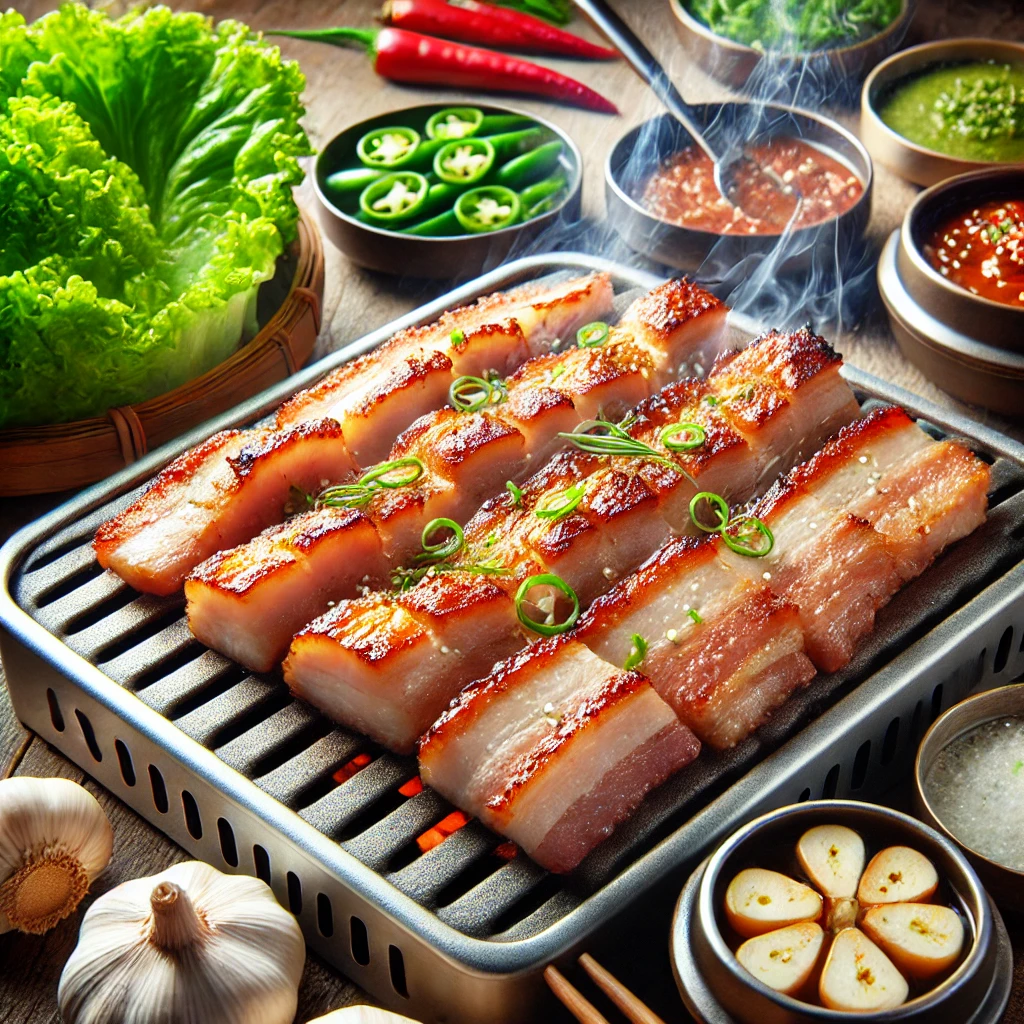If there’s one dish that perfectly captures the communal and interactive nature of Korean dining, it’s Samgyeopsal (삼겹살). Samgyeopsal is a Korean grilled pork belly dish that is both simple and incredibly satisfying. The thick slices of pork belly are cooked right at the table on a grill, often accompanied by a variety of side dishes (banchan), dipping sauces, and vegetables. This dish is all about assembling your own perfect bite, usually with a piece of pork belly wrapped in a fresh lettuce leaf with various condiments like ssamjang (a savory dipping sauce) and kimchi.
Samgyeopsal is more than just a meal—it’s an experience that brings people together, whether in restaurants or at home. The sizzling sound of the pork on the grill, the aroma of the meat cooking, and the customizable nature of the dish make it a staple of Korean barbecue.
What is Samgyeopsal?
Samgyeopsal literally means “three-layered flesh,” referring to the layers of fat and meat in the pork belly. Unlike bacon, which is typically thinly sliced and cured, samgyeopsal is thick-cut and unseasoned, allowing the natural flavors of the pork to shine through when grilled. It’s this simplicity that makes samgyeopsal such a popular dish.
The grilled pork belly is typically cut into bite-sized pieces after cooking and served with a variety of accompaniments, including lettuce or perilla leaves for wrapping, ssamjang (a spicy dipping sauce made with gochujang and doenjang), raw garlic, green chili peppers, and pickled vegetables. The beauty of samgyeopsal is that you can customize each bite to your liking, creating endless flavor combinations.
The Experience of Eating Samgyeopsal
One of the most exciting aspects of samgyeopsal is that it’s cooked right at the table. In Korean restaurants, each table is equipped with a grill where diners cook the meat themselves. This hands-on experience is part of what makes Korean BBQ so special. You control the cooking process, grilling the pork belly until it reaches the perfect level of crispiness on the outside while remaining juicy on the inside.
After the pork is grilled, it’s wrapped in fresh lettuce leaves (known as ssam) along with various toppings like garlic, green onions, kimchi, and dipping sauces. The result is a flavorful, crunchy, and juicy bite that’s both refreshing and rich.
The History and Cultural Importance of Samgyeopsal
Samgyeopsal has been a beloved dish in Korea for decades, though its popularity surged in the late 20th century. It’s particularly associated with gatherings of friends and family, as well as social occasions where the interactive nature of the meal encourages conversation and camaraderie. Unlike some other traditional Korean dishes that require more complex preparation, samgyeopsal’s simplicity and focus on fresh ingredients make it accessible to everyone.
This dish is often enjoyed with soju, a popular Korean alcoholic drink, which pairs perfectly with the fatty, grilled pork. In Korean culture, samgyeopsal and soju have become synonymous with casual gatherings and celebrations.
Key Ingredients: What Makes Samgyeopsal Special?
The success of samgyeopsal lies in its simple yet high-quality ingredients. Here’s what you need to create an authentic samgyeopsal experience:
- Pork Belly: The star of the dish. Look for thick, fresh pork belly with visible layers of fat and meat. The fat renders out during grilling, leaving the meat tender and juicy.
- Lettuce or Perilla Leaves: Fresh greens are used to wrap the grilled pork, creating a crunchy, refreshing bite. Perilla leaves (also known as sesame leaves) have a slightly minty flavor that complements the richness of the pork.
- Ssamjang: This is the key dipping sauce, made from a blend of gochujang (Korean red chili paste), doenjang (fermented soybean paste), garlic, sesame oil, and sugar. It’s spicy, savory, and slightly sweet.
- Garlic and Green Chili Peppers: Thin slices of garlic and green chili peppers add a sharp, spicy contrast to the fatty pork.
- Kimchi: No Korean meal is complete without kimchi. The tangy, spicy, and fermented flavors of kimchi balance out the richness of the pork belly.
- Rice: Steamed white rice is often served alongside the grilled meat, providing a neutral base to accompany the strong flavors.
How to Make Samgyeopsal at Home
Though typically enjoyed in restaurants, samgyeopsal is easy to recreate at home with a few key ingredients and a tabletop grill or pan. Here’s a basic recipe to guide you:
Ingredients:
- 1 lb (450g) pork belly, thickly sliced
- 1 head of lettuce or a bunch of perilla leaves
- 1/2 cup ssamjang (Korean dipping sauce)
- 1/2 cup kimchi
- 4 garlic cloves, thinly sliced
- 2 green chili peppers, sliced
- 2 cups steamed rice
- Sesame oil for grilling
- Soy sauce (optional)
Instructions:
- Prepare the Ingredients: Arrange the lettuce or perilla leaves, sliced garlic, green chilies, kimchi, and steamed rice on a serving platter.
- Heat the Grill: If you’re using a tabletop grill, heat it to medium-high. If you don’t have a grill, a large pan or cast-iron skillet will work just as well. Lightly grease the grill or pan with sesame oil.
- Grill the Pork Belly: Place the thick slices of pork belly on the grill and cook for 2-3 minutes on each side, until the outside is crispy and the fat is rendered. Cut the pork belly into bite-sized pieces as it cooks.
- Assemble the Wraps: Once the pork is cooked, take a piece of lettuce or perilla leaf, add a slice of grilled pork, a dollop of ssamjang, a slice of garlic, chili pepper, and some kimchi. Wrap it up into a small bundle and eat in one bite!
- Serve: Samgyeopsal is best enjoyed hot off the grill. Serve with rice and additional dipping sauces for a complete meal.
Variations of Samgyeopsal
There are several ways to customize and elevate your samgyeopsal experience:
- Marinated Samgyeopsal: While traditional samgyeopsal is unseasoned, you can marinate the pork belly in a mixture of soy sauce, garlic, sugar, and sesame oil for extra flavor.
- Cheese Samgyeopsal: Cheese lovers will enjoy dipping the grilled pork into a melted cheese dip, a modern twist that has become popular in Korea.
- Mushroom Samgyeopsal: Add mushrooms like king oyster or shiitake to the grill for a meaty, umami-rich addition to the meal.
- Beef Samgyeopsal: If pork belly isn’t your preference, you can substitute with beef short ribs (galbi) or ribeye steak for a leaner alternative.
Nutritional Benefits of Samgyeopsal
Samgyeopsal is a protein-rich dish that’s balanced by the fresh vegetables and condiments it’s served with. The combination of grilled pork, garlic, and leafy greens creates a meal that’s both flavorful and packed with nutrients. While pork belly is higher in fat, it’s also a good source of protein and essential vitamins like B12 and iron. The fresh greens provide fiber, vitamins, and minerals, making each bite not only delicious but also nutritious.
The use of garlic and chili peppers in samgyeopsal also provides health benefits, including boosting immunity and improving digestion.
The Communal Experience of Samgyeopsal
In Korea, samgyeopsal is more than just food—it’s a social experience. Whether you’re at a restaurant or grilling at home, the communal nature of Korean BBQ fosters connection and conversation. Everyone gathers around the grill, cooking and sharing food together, which adds to the enjoyment of the meal.
This interactive dining experience is often accompanied by soju, a popular Korean liquor, which pairs perfectly with the rich flavors of the pork belly. In fact, samgyeopsal and soju are considered an iconic pairing in Korean food culture.
Conclusion
Samgyeopsal is a beloved Korean dish that brings together the simplicity of grilled pork belly with the vibrant flavors of fresh vegetables, dipping sauces, and kimchi. It’s a dish that invites people to gather, cook, and share food in a way that’s as much about the experience as it is about the taste. Whether you’re enjoying it at a bustling restaurant or recreating it at home with friends and family, samgyeopsal is a flavorful and fun way to experience Korean cuisine.






